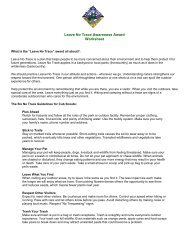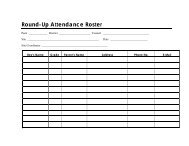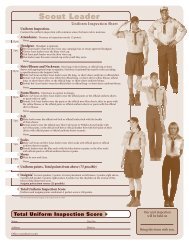BSA Guide To Safe Scouting 34416 - Hot4CAD Online
BSA Guide To Safe Scouting 34416 - Hot4CAD Online
BSA Guide To Safe Scouting 34416 - Hot4CAD Online
- No tags were found...
You also want an ePaper? Increase the reach of your titles
YUMPU automatically turns print PDFs into web optimized ePapers that Google loves.
VIII. Sports and ActivitiesThe Sweet 16 of <strong>BSA</strong> <strong>Safe</strong>tyThese 16 safety points, which embody good judgmentand common sense, are applicable to all activities:1. Qualified Supervision. Every <strong>BSA</strong> activity should besupervised by a conscientious adult who understandsand knowingly accepts responsibility for the well-beingand safety of the children and youth in his or her care.The supervisor should be sufficiently trained, experienced,and skilled in the activity to be confident of his orher ability to lead and teach the necessary skills and torespond effectively in the event of an emergency. Fieldknowledge of all applicable <strong>BSA</strong> standards and a commitmentto implement and follow <strong>BSA</strong> policy and proceduresare essential parts of the supervisor’s qualifications.2. Physical Fitness. For youth participants in any potentiallystrenuous activity, the supervisor should receive acomplete health history from a health-care professional,parent, or guardian. Adult participants and youthinvolved in higher-risk activities (e.g., scuba diving)may have to undergo professional evaluation in additionto completing the health history. The supervisor shouldadjust all supervision, discipline, and protection toanticipate potential risks associated with individualhealth conditions. Neither youth nor adults should participatein activities for which they are unfit. <strong>To</strong> do sowould place both the individual and others at risk.3. Buddy System. The long history of the “buddy system”in <strong>Scouting</strong> has shown that it is always best to have atleast one other person with you and aware at all timesof your circumstances and what you are doing in anyoutdoor or strenuous activity.4. <strong>Safe</strong> Area or Course. A key part of the supervisors’ responsibilityis to know the area or course for the activity and todetermine that it is well-suited and free of hazards.5. Equipment Selection and Maintenance. Most activityrequires some specialized equipment. The equipmentshould be selected to suit the participants and theactivity and to include appropriate safety and programfeatures. The supervisor should also check equipment todetermine whether it is in good condition for the activityand make sure it is kept properly maintained while in use.6. Personal <strong>Safe</strong>ty Equipment. The supervisor must assurethat every participant has and uses the appropriatepersonal safety equipment. For example, activity afloatrequires that each participant properly wear a life jacket;bikers, horseback riders, and whitewater kayakers needhelmets for certain activities; skaters need protectivegear; and all need to be dressed for warmth and utilityas the circumstances require.7. <strong>Safe</strong>ty Procedures and Policies. For most activities,common-sense procedures and standards can greatlyreduce any risk. These should be known and appreciatedby all participants, and the supervisor mustassure compliance.8. Skill Level Limits. Every activity has a minimum skilllevel, and the supervisor must identify and recognizethis level and be sure that participants are not put atrisk by attempting any activity beyond their abilities.A good example of skill levels in <strong>Scouting</strong> is the swimtest, which defines conditions for safe swimming onthe basis of individual ability.9. Weather Check. The risks of many outdoor activitiesvary substantially with weather conditions. Potentialweather hazards and the appropriate responses shouldbe understood and anticipated.10. Planning. <strong>Safe</strong> activity follows a plan that has been conscientiouslydeveloped by the experienced supervisor orother competent source. Good planning minimizes risksand also anticipates contingencies that may require anemergency response or a change of plan.11. Communications. The supervisor needs to be ableto communicate effectively with participants as neededduring the activity. Emergency communicationsalso need to be considered in advance for anyforeseeable contingencies.12. Permits and Notices. <strong>BSA</strong> tour permits, council officeregistration, government or landowner authorization,and any similar formalities are the supervisor’sresponsibility when such are required. Appropriatenotification should be directed to parents, enforcementauthorities, landowners, and others as needed,before and after the activity.The online version of the <strong>Guide</strong> to <strong>Safe</strong> <strong>Scouting</strong> is updated quarterly.Go to http://www.scouting.org/Healthand<strong>Safe</strong>ty/GSS.aspx.31








